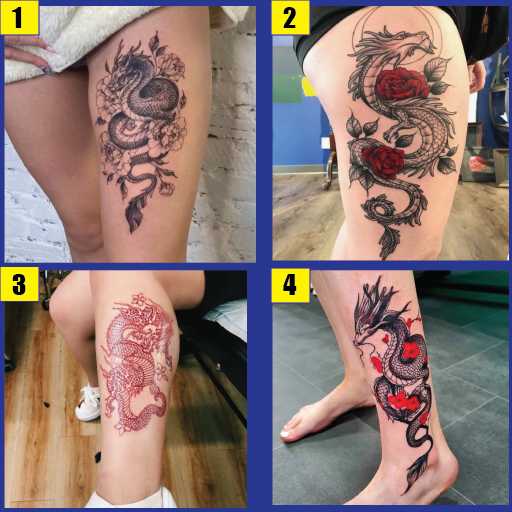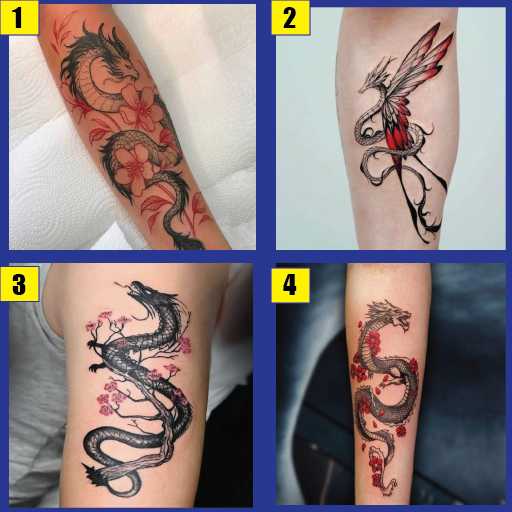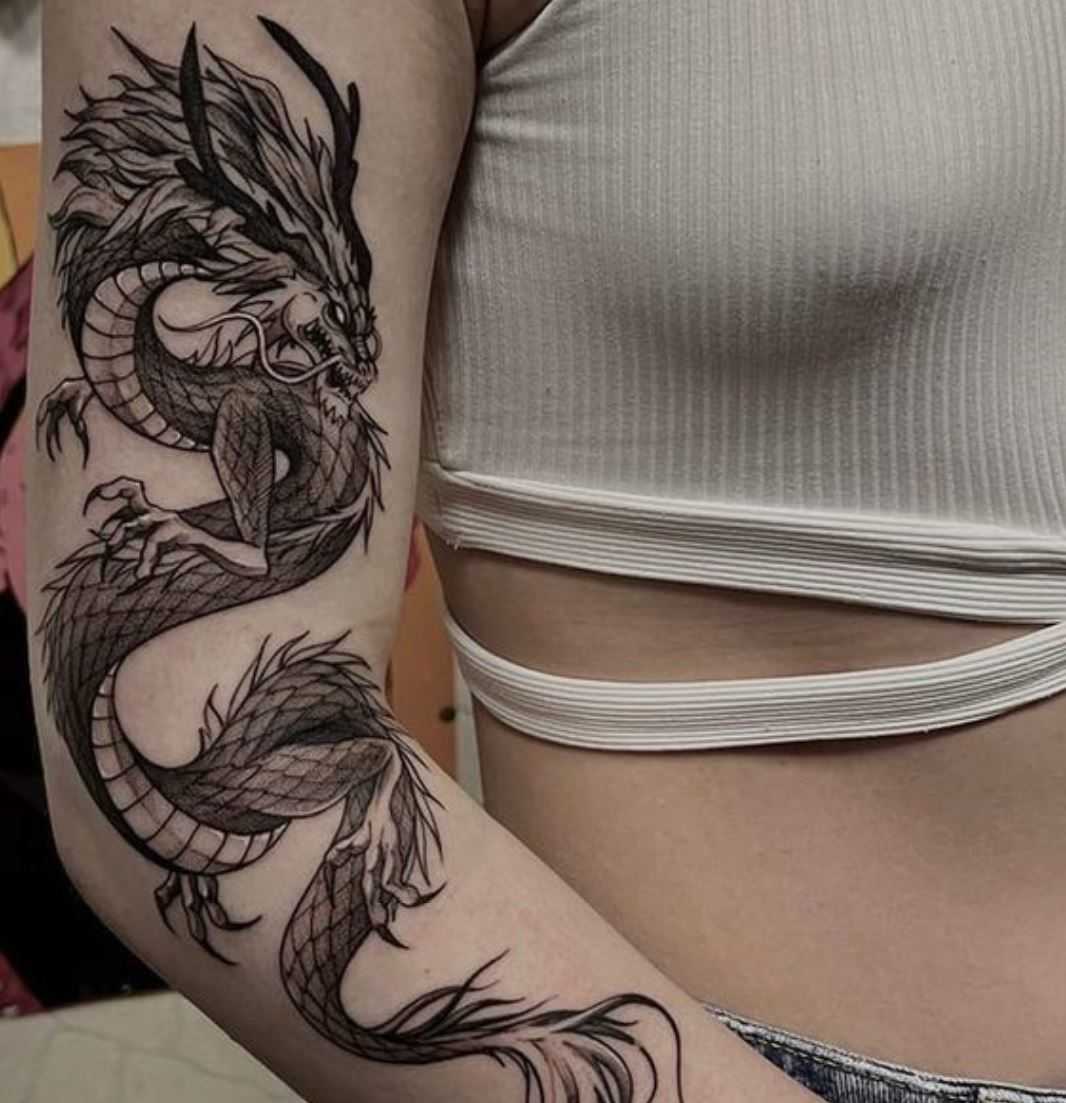Dragon tattoos are incredibly popular due to their bold aesthetics and profound symbolism. These mythical creatures often symbolize strength, courage, wisdom, and protection in various cultures. Depending on the design, a dragon tattoo can either convey ferocity and power or serenity and wisdom.
In terms of color, the choice depends on the wearer’s preference and the cultural context of the dragon. Traditional Asian dragon tattoos often utilize black and grey ink with red, blue, or green accents, while Western dragon designs might incorporate a broader spectrum of colors. A red dragon may symbolize passion and raw power, a blue dragon can signify wisdom and tranquility, while a black dragon may denote mystery and depth.
Best part of the body for a Dragon tattoo
The dragon’s intricate details and flexible shape make it suitable for various parts of the body. For smaller, more delicate designs, the wrist, ankle, or behind the ear are excellent choices. Larger dragons can be etched across the back, chest, or wrapped around the arm or leg as a sleeve.
Why people choose Dragon tattoo
Choosing a dragon tattoo comes with a number of advantages. First, it offers tremendous versatility in design – from traditional Asian or tribal styles to modern, abstract interpretations. Second, the rich symbolism associated with dragons allows individuals to express a variety of personal qualities or aspirations, from strength and resilience to spiritual growth. Lastly, a well-designed dragon tattoo can be a striking piece of art, making a bold statement and attracting attention.
How to take care of a Dragon tattoo
Taking care of a dragon tattoo, or any new tattoo, involves some specific steps to promote healing and maintain the vibrancy of the tattoo:
Keep it Covered: Immediately after getting your tattoo, your artist will cover it with a bandage or plastic wrap. This protects the tattoo from airborne bacteria and should be kept on for a few hours, up to 24 hours as directed by your artist.
Clean the Tattoo: Once you remove the bandage, you’ll need to clean the area with lukewarm water and a gentle, fragrance-free soap. Avoid using a washcloth or anything that could be abrasive. Use your hands to clean the tattoo gently.
Pat it Dry: Don’t rub the tattoo with a towel. Instead, pat it gently with a clean towel or allow it to air dry.
Moisturize: Apply a thin layer of a fragrance-free, specialized tattoo aftercare lotion or ointment. This will keep your skin hydrated and help the healing process.
Avoid Sun Exposure: Try to keep the tattoo out of direct sunlight, as UV rays can damage the healing tattoo and cause the colors to fade.
Don’t Soak or Swim: Until your tattoo is fully healed, avoid soaking it in water, which means no swimming in pools, hot tubs, or the ocean.
Let it Heal Naturally: Your tattoo will start to peel after a few days, much like a sunburn. Don’t pick at it or scratch it. Let it heal naturally.
Stay Healthy: Your overall health can affect the healing of your tattoo. Eat healthily, stay hydrated, and get enough sleep.
The healing process generally takes around two weeks for the surface skin to heal and up to two months for the deeper layers. Always follow the specific aftercare instructions given by your tattoo artist, and if you see any signs of an infection, such as excessive redness, swelling, or pus, contact a healthcare provider immediately.
Dragon Tattoo Designs


How to take care of a Dragon tattoo
Taking care of a dragon tattoo, or any new tattoo, involves some specific steps to promote healing and maintain the vibrancy of the tattoo:
Keep it Covered: Immediately after getting your tattoo, your artist will cover it with a bandage or plastic wrap. This protects the tattoo from airborne bacteria and should be kept on for a few hours, up to 24 hours as directed by your artist.
Clean the Tattoo: Once you remove the bandage, you’ll need to clean the area with lukewarm water and a gentle, fragrance-free soap. Avoid using a washcloth or anything that could be abrasive. Use your hands to clean the tattoo gently.
Pat it Dry: Don’t rub the tattoo with a towel. Instead, pat it gently with a clean towel or allow it to air dry.
Moisturize: Apply a thin layer of a fragrance-free, specialized tattoo aftercare lotion or ointment. This will keep your skin hydrated and help the healing process.
Avoid Sun Exposure: Try to keep the tattoo out of direct sunlight, as UV rays can damage the healing tattoo and cause the colors to fade.
Don’t Soak or Swim: Until your tattoo is fully healed, avoid soaking it in water, which means no swimming in pools, hot tubs, or the ocean.
Let it Heal Naturally: Your tattoo will start to peel after a few days, much like a sunburn. Don’t pick at it or scratch it. Let it heal naturally.
Stay Healthy: Your overall health can affect the healing of your tattoo. Eat healthily, stay hydrated, and get enough sleep.
The healing process generally takes around two weeks for the surface skin to heal and up to two months for the deeper layers. Always follow the specific aftercare instructions given by your tattoo artist, and if you see any signs of an infection, such as excessive redness, swelling, or pus, contact a healthcare provider immediately.
Source: Scopenew.com – Guide










